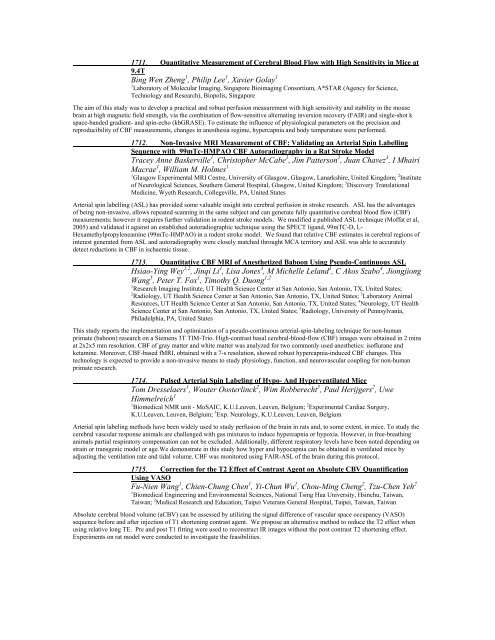Traditional Posters: Diffusion & Perfusion - ismrm
Traditional Posters: Diffusion & Perfusion - ismrm
Traditional Posters: Diffusion & Perfusion - ismrm
You also want an ePaper? Increase the reach of your titles
YUMPU automatically turns print PDFs into web optimized ePapers that Google loves.
1711. Quantitative Measurement of Cerebral Blood Flow with High Sensitivity in Mice at<br />
9.4T<br />
Bing Wen Zheng 1 , Philip Lee 1 , Xavier Golay 1<br />
1 Laboratory of Molecular Imaging, Singapore Bioimaging Consortium, A*STAR (Agency for Science,<br />
Technology and Research), Biopolis, Singapore<br />
The aim of this study was to develop a practical and robust perfusion measurement with high sensitivity and stability in the mouse<br />
brain at high magnetic field strength, via the combination of flow-sensitive alternating inversion recovery (FAIR) and single-shot k<br />
space-banded gradient- and spin-echo (kbGRASE). To estimate the influence of physiological parameters on the precision and<br />
reproducibility of CBF measurements, changes in anesthesia regime, hypercapnia and body temperature were performed.<br />
1712. Non-Invasive MRI Measurement of CBF: Validating an Arterial Spin Labelling<br />
Sequence with 99mTc-HMPAO CBF Autoradiography in a Rat Stroke Model<br />
Tracey Anne Baskerville 1 , Christopher McCabe 1 , Jim Patterson 2 , Juan Chavez 3 , I Mhairi<br />
Macrae 1 , William M. Holmes 1<br />
1 Glasgow Experimental MRI Centre, University of Glasgow, Glasgow, Lanarkshire, United Kingdom; 2 Institute<br />
of Neurological Sciences, Southern General Hospital, Glasgow, United Kingdom; 3 Discovery Translational<br />
Medicine, Wyeth Research, Collegeville, PA, United States<br />
Arterial spin labelling (ASL) has provided some valuable insight into cerebral perfusion in stroke research. ASL has the advantages<br />
of being non-invasive, allows repeated scanning in the same subject and can generate fully quantitative cerebral blood flow (CBF)<br />
measurements; however it requires further validation in rodent stroke models. We modified a published ASL technique (Moffat et al,<br />
2005) and validated it against an established autoradiographic technique using the SPECT ligand, 99mTC-D, L-<br />
Hexamethylpropyleneamine (99mTc-HMPAO) in a rodent stroke model. We found that relative CBF estimates in cerebral regions of<br />
interest generated from ASL and autoradiography were closely matched throught MCA territory and ASL was able to accurately<br />
detect reductions in CBF in ischaemic tissue.<br />
1713. Quantitative CBF MRI of Anesthetized Baboon Using Pseudo-Continuous ASL<br />
Hsiao-Ying Wey 1,2 , Jinqi Li 1 , Lisa Jones 3 , M Michelle Leland 3 , C Akos Szabo 4 , Jiongjiong<br />
Wang 5 , Peter T. Fox 1 , Timothy Q. Duong 1,2<br />
1 Research Imaging Institute, UT Health Science Center at San Antonio, San Antonio, TX, United States;<br />
2 Radiology, UT Health Science Center at San Antonio, San Antonio, TX, United States; 3 Laboratory Animal<br />
Resources, UT Health Science Center at San Antonio, San Antonio, TX, United States; 4 Neurology, UT Health<br />
Science Center at San Antonio, San Antonio, TX, United States; 5 Radiology, University of Pennsylvania,<br />
Philadelphia, PA, United States<br />
This study reports the implementation and optimization of a pseudo-continuous arterial-spin-labeling technique for non-human<br />
primate (baboon) research on a Siemens 3T TIM-Trio. High-contrast basal cerebral-blood-flow (CBF) images were obtained in 2 mins<br />
at 2x2x5 mm resolution. CBF of gray matter and white matter was analyzed for two commonly used anesthetics: isoflurane and<br />
ketamine. Moreover, CBF-based fMRI, obtained with a 7-s resolution, showed robust hypercapnia-induced CBF changes. This<br />
technology is expected to provide a non-invasive means to study physiology, function, and neurovascular coupling for non-human<br />
primate research.<br />
1714. Pulsed Arterial Spin Labeling of Hypo- And Hyperventilated Mice<br />
Tom Dresselaers 1 , Wouter Oosterlinck 2 , Wim Robberecht 3 , Paul Herijgers 2 , Uwe<br />
Himmelreich 1<br />
1 Biomedical NMR unit - MoSAIC, K.U.Leuven, Leuven, Belgium; 2 Experimental Cardiac Surgery,<br />
K.U.Leuven, Leuven, Belgium; 3 Exp. Neurology, K.U.Leuven, Leuven, Belgium<br />
Arterial spin labeling methods have been widely used to study perfusion of the brain in rats and, to some extent, in mice. To study the<br />
cerebral vascular response animals are challenged with gas mixtures to induce hypercapnia or hypoxia. However, in free-breathing<br />
animals partial respiratory compensation can not be excluded. Additionally, different respiratory levels have been noted depending on<br />
strain or transgenic model or age.We demonstrate in this study how hyper and hypocapnia can be obtained in ventilated mice by<br />
adjusting the ventilation rate and tidal volume. CBF was monitored using FAIR-ASL of the brain during this protocol.<br />
1715. Correction for the T2 Effect of Contrast Agent on Absolute CBV Quantification<br />
Using VASO<br />
Fu-Nien Wang 1 , Chien-Chung Chen 1 , Yi-Chun Wu 1 , Chou-Ming Cheng 2 , Tzu-Chen Yeh 2<br />
1 Biomedical Engineering and Environmental Sciences, National Tsing Hua University, Hsinchu, Taiwan,<br />
Taiwan; 2 Medical Research and Education, Taipei Veterans General Hospital, Taipei, Taiwan, Taiwan<br />
Absolute cerebral blood volume (aCBV) can be assessed by utilizing the signal difference of vascular space occupancy (VASO)<br />
sequence before and after injection of T1 shortening contrast agent. We propose an alternative method to reduce the T2 effect when<br />
using relative long TE. Pre and post T1 fitting were used to reconstruct IR images without the post contrast T2 shortening effect.<br />
Experiments on rat model were conducted to investigate the feasibilities.















